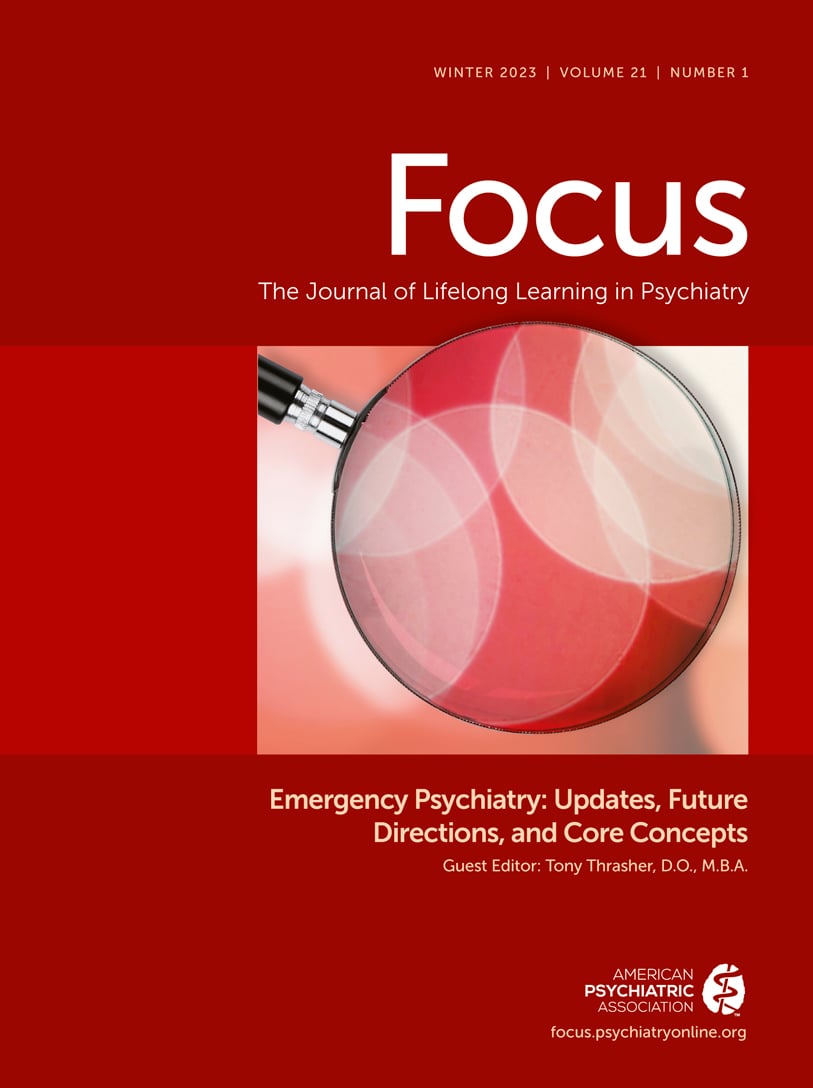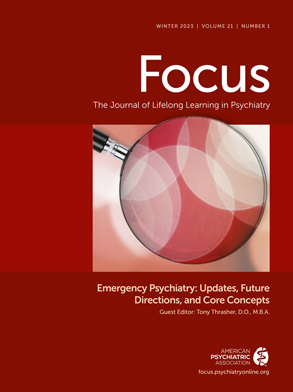Psychiatrists are not typically the first professionals on the scene interacting with agitated patients experiencing a psychiatric emergency. Police and security personnel may have brought the patient to the ED and remain present to maintain staff safety. Nurses and other health care staff are also present. In this crisis setting, the potential for violence of the patient toward personnel or for the personnel to invoke coercive methods to quell the agitation, such as restraints and involuntary medication, is high. This level of intervention may be necessary to maintain patient and staff safety in some situations. However, increased emphasis and training is required to ensure that all ED staff have expertise in noncoercive methods to assist the patient in gaining control using trauma-informed skills (
3). “Experienced practitioners have found that if such interventions are undertaken with genuine commitment, successful outcomes can occur far more often than previously thought possible” (
8). Although staff in hospital mental health care settings are routinely trained in de-escalation techniques, psychiatrists have often been “the prescribers” in the emergency care rather than actively, empathically, and collaboratively helping patients calm themselves (
9). The psychiatrist may be in the best position to evaluate the probable causes of the agitation, such as trauma, panic, substance use, psychosis, or other medical or behavioral issues.
Trauma-informed care is an essential element of crisis treatment. SAMHSA (
3) set guiding principles for trauma-informed care. They include safety for patient and staff; trustworthiness and transparency; peer support and mutual self-help; collaboration and mutuality; empowerment, voice, and choice; and ensuring that cultural, historical, and gender considerations inform the care provided. The issues of implicit bias must be considered with each encounter. A systematic review found that health care professionals tend to associate Black patients with being less cooperative, compliant, and responsible in comparison with White patients (
10). Another study reported that clinicians tend to associate Hispanic patients with medical noncompliance and partaking in risky behaviors (
11). Research also indicates that racial disparities are present in the decision to restrain a patient. Black patients are more likely to be restrained while in the ED, even when controlling for confounding variables, such as diagnosis, sex, age, homelessness, and violence (
12,
13). Trauma-informed best practices include attention to this potential bias each time an agitated patient presents to the ED.
Clinical Vignette
Ms. Cathy Smith is a 33-year-old mother of two who was diagnosed as having bipolar disorder at the age of 23 while she was in her first year of law school. Ms. Smith cared deeply about her children (ages 6 and 8) and worked to ensure that they attended the best school in the area. When her mood was stable, she was kind and nurturing. However, when she did not take her medication or her symptoms broke through, she lost motivation and neglected the children. More concerning was when Ms. Smith suffered a manic episode: She became agitated and threatening, declared that her children were not hers and were imposters, and claimed that she was married to movie stars. Mr. Smith, her husband, drove trucks on long-distance routes and often was not there to take over when Ms. Smith was becoming ill. Her disabling mood symptoms had become increasingly more common and more severe. She was a “frequent flier” to the ED. Staff were concerned and fearful when she came, as she was quite agitated and had attacked a nurse during one of her psychiatric emergency visits. Today, Ms. Smith was brought in by ambulance in restraints, and she struggled to pull free while screaming profanities and threats.
“Whose turn is it to work with Ms. Smith today?” the charge nurse inquired, a note of sarcasm in his voice.
“Well,” Dr. Hayes replied in an apprehensive tone. “Give me a mindfulness minute and I will see what I can do to be helpful.” Dr. Hayes had perfected brief mindfulness practice as an effective method of calming and remaining in the moment.
When Dr. Hayes went into the room with Ms. Smith, she remained in restraints and was still struggling. When Dr. Hayes approached, Ms. Smith spit at her.
“Shall I get an IM prn [intramuscular injection as needed], Dr. Hayes?” the assigned nurse asked.
“No, not yet, please,” Dr. Hayes replied.
Dr. Hayes left the room, retrieved a chair, and brought it into the room. She sat down to be more at Ms. Smith’s eye level but not so close as to be threatening. The security officers stood a few feet away, at the ready.
“Hello, Ms. Smith,” she began. “I am Dr. Hayes, the psychiatrist. I am sorry that you are in restraints, but it’s not OK to shake the gurney, yell, and spit. Please stop so that I can ask the security guards to stand outside the room and we can talk about what you need. OK?”
“Yes, get the [expletive] out of my sight,” Ms. Smith spewed toward the security officers.
Dr. Hayes nodded, and the security guards left the room and stood outside the open door, just out of Ms. Smith’s sight. Dr. Hayes thanked them. The room was quieter, and no one was standing over Ms. Smith as she remained in restraints.
“Get these [expletive] things off of me,” Ms. Smith insisted, tugging at the restraints.
Dr. Hayes gazed empathically into Ms. Smith’s eyes. “I don’t blame you for being upset. The restraints look uncomfortable. I would like to work together to be sure you can be safe so they can be removed.”
“You all are just on a power trip to see if you can subdue a celebrity,” Ms. Smith said scornfully.
Dr. Hayes remained silent. After a long pause, Dr. Hayes said quietly, “Would you like to listen to music to calm down? I was told you are a Beyoncé fan.”
Ms. Smith’s muscles were tense, but she had stopped struggling and cursing. “Last time I tried that, the police came and took my earbuds away,” Ms. Smith complained.
“I’ll tell you what—as long as you can remain safe, I will ask if you can keep them. You need to be safe, though.”
“Sure, sure,” Ms. Smith replied. “My husband, George Clooney, doesn’t even know I’m here. I need to call him right now! He will come get me.”
“I’m sorry. No calls,” Dr. Hayes replied. “The nurse is going to get the earbuds and the Beyoncé mix.”
Both waited quietly until the earbuds appeared.
“Thank you for calming down, Ms. Smith,” Dr. Hayes said sincerely. “Would you rather start the music now, or wait until you are out of restraints?” Dr. Hayes asked.
“Now,” Ms. Smith replied quickly.
“OK, but we can’t have them too loud, as we still need to be able to talk. I am trusting you that you will not hurt me after the restraints are removed,” Dr. Hayes said matter-of-factly.
“I won’t hurt you,” Ms. Smith replied.
“And no hurting others, as well,” Dr. Hayes added.
“Not as long as they keep their filthy hands off me,” Ms. Smith replied.
“If you are calm and safe, there will be no need for hands on,” Dr. Hayes reassured her, “but that is up to you. You need to be safe.”
The earbuds were placed carefully in Ms. Smith’s ear canals, and the music started. Over the next 5 minutes, Ms. Smith’s body relaxed, and she began to sway with the music.
“May we bring you your medication now?” Dr. Hayes queried. “I think you missed some doses of olanzapine, so we want to restart it.”
“Yuck,” Ms. Smith said loudly, but she took the medication as offered. The security guards removed the restraints over the next 15 minutes, as Ms. Smith remained calm.
On debriefing after having been in behavioral control for some time, Ms. Smith reported that she thought listening to music and “being left alone and not touched” works best to help her calm when she is upset. Staff debriefing suggested that having police and others close by but out of sight and using music was helpful. They found Dr. Hayes’s approach effective and instructive.

